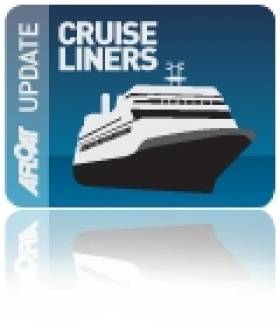Displaying items by tag: Dun Laoghaire Harbour
Busy Autumn Sailing Scene in Dun Laoghaire
Is Dun Laoghaire Harbour a busier dinghy sailing venue on Autumn Sundays than it is in Summer? Certainly if yesterday's activity at the National Yacht Club, Royal St. George YC, Royal Irish, Irish National Sailing School and DMYC is anything to go by.
While Anthony O'Leary was winning the All Ireland sailing championships just off the harbour mouth there was no less than six other fleets racing or race training in and around the east coast port. Just as the season is meant to be tapering off Fireflies were team racing from the Royal St. George Yacht Club and Fireballs were giving 'just for fun' demo sails from the DMYC but far and away the main point of interest in the NYC was for the Jelly Bean Junior Regatta (pictured above) that had a variety of fleets racing across the harbour.
In addition Laser 4.7s were training in Scotsman's Bay and a number of foiling Moths came out to play when the breeze puffed up to 15 knots yesterday afternoon. A perfect breeze to give the INSS novices plenty of fun on the east bight in colourful Laser Pico dinghies.
If there was any disappointment it was that there were few – if any at Ireland's biggest sailing centre – that ventured out to spectate at a thrilling final of the All Ireland Sailing Championships but that's because Dun Laoghaire sailors were all too busy sailing themselves?
German Corvette Cancels Dun Laoghaire Visit Diverts to Dublin
#GermanCorvetteCancels – A German Navy corvette due to make a four-day visit to Dun Laoghaire Harbour including as previously reported, scheduled public tours this weekend have been cancelled, writes Jehan Ashmore.
According to the ships agent, the 1,850 tonne corvette FGS Ludwigshafen am Rhein (F264) had sought the supply of fenders to meet the requirement of the 90m long vessel alongside Carlisle Pier. It is understood that such fenders were due to be installed but will not be ready in time for the naval visitor.
The Carlisle Pier is where in recent years small sized cruiseships have berthed, notably the largest and most frequent caller is the sail-assisted five-mast 310 passenger Wind Surf of 14,745 tonnes.
Instead of calling to Dun Laoghaire, the FGS Ludwigshafen am Rhein, the final member of five ‘Braunschweig’ class corvettes is to divert to Dublin Port with an arrival tomorrow (Friday) morning.
Some four hours later, Dublin Port welcomes a second foreign naval caller, the UK’s HMS Dauntless (D33), one of the most modern high-tech destroyers currently in service for the Royal Navy.
Due to unforeseen circumstances German Navy #LuwigshafenAmRhein will not visit @dlharbour this weekend. Apologies for inconvenience
— DúnLaoghaire Harbour (@DLHarbour) September 24, 2015Irish Sailing Can Take Heart From Dun Laoghaire School’s Latest Record Turnout
Anyone feeling a bit despondent about the future of Irish sailing, what with the disappointing weather for periods of the 2015 season, plus the lack of some really high profile international racing successes, would have had their sprits lifted mightily – and then some – by being around the Irish National Sailing School in Dun Laoghaire last weekend writes W M Nixon
This remarkable organisation, whose background and lively ongoing story we profiled on Afloat.ie on 16th May, have seen their records of numbers participating raised again and again through the summer as the numbers of trainees – from absolute beginners right up to wannabe offshore crews in the school’s Reflex 38 Lynx - have steadily increased, until a new peak was reached last Saturday when absolutely every boat in the club’s large and varied fleet was in constant action, with new participant levels achieved.
Other organisations in the sailing school sector used to wonder in admiration after the INSS began to get regular turnouts of more than 150 schoolchildren per day – when we were visiting on Monday May 10th, 185 schoolkids had been bussed down from Maynooth and were having the time of their lives afloat, many for the very first time.
Nevertheless, while 185 or even 190 participants in the INSS’s schoolchildren division were fairly frequent occurrences, it wasn’t until last Saturday - a great and golden day whatever the weather - that they finally surpassed the 200 mark for members of their Junior Club - aged 7 and over – afloat and learning how best to enjoy the wonders of boats and sailing.
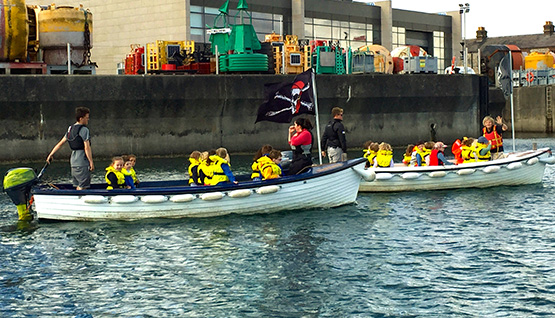 You get them into sailing in gentle stages. With toddlers and infants, just going out on a boat with a feeling of safety is a good first stage – this is Muriel Rumball (lead boat) with the most junior class – some of their parents may themselves be afloat with the INSS learning to sail in larger craft.
You get them into sailing in gentle stages. With toddlers and infants, just going out on a boat with a feeling of safety is a good first stage – this is Muriel Rumball (lead boat) with the most junior class – some of their parents may themselves be afloat with the INSS learning to sail in larger craft.
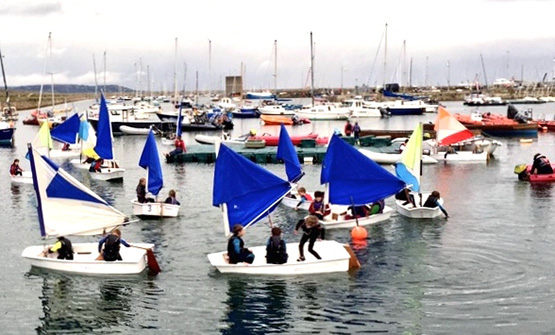 The first stages in sailing should be more about manageability than technical tuning – an Optimist with its sprit out of use lends itself well to fun afloat while gently familiarising the kids with the basics of sailing and getting on with others in the confines of a boat.
The first stages in sailing should be more about manageability than technical tuning – an Optimist with its sprit out of use lends itself well to fun afloat while gently familiarising the kids with the basics of sailing and getting on with others in the confines of a boat.
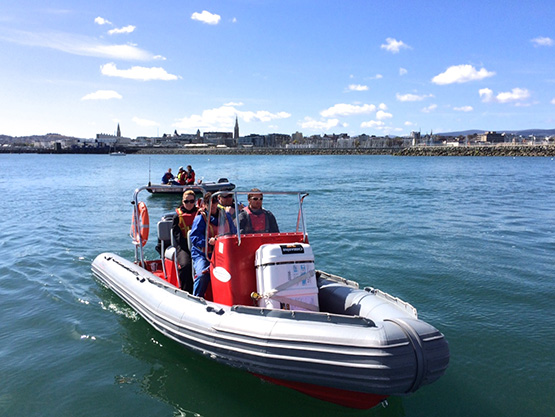 The powerful RIB Sting could be a lethal weapon in the wrong hands, but as she is one of the boats in the INSS Powerboat Course, her competent use is a feature of the school’s activities.
The powerful RIB Sting could be a lethal weapon in the wrong hands, but as she is one of the boats in the INSS Powerboat Course, her competent use is a feature of the school’s activities.
But that was only the start of it, for the school’s popular National Powerboat Course was running for the whole weekend with full turnouts, while the rest of the Schools’ sailing fleet, including 1720s and the Reflex 38 offshore racer, had more than 30 out in adult beginner training courses.
In our report of May 15th, we particularly remembered being in at the beginning of the historic first committee meeting of the newest club in Ireland, the Irish National Sailing Club, which enables the Sailing School alumni to take part in official regattas anywhere, and other open events, for the princely annual subscription of €10.
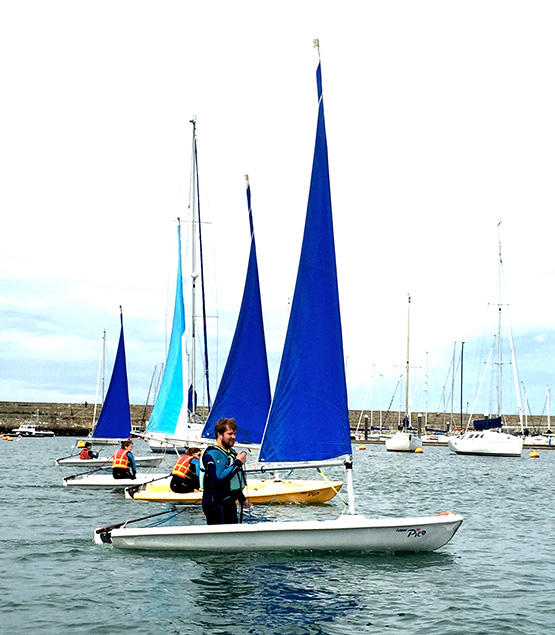 The highly durable Pico is one of the key boats in the INSS’s intermediate courses
The highly durable Pico is one of the key boats in the INSS’s intermediate courses
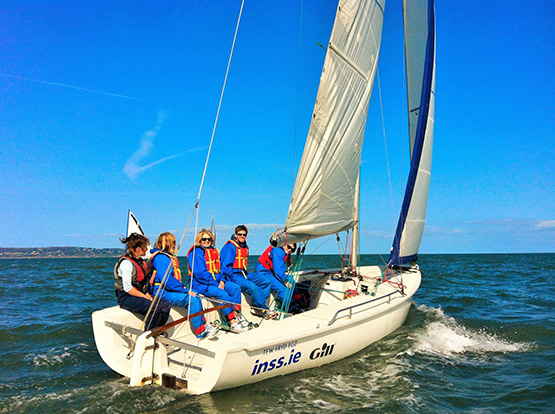 When Tony Castro designed the 1720 Sportboat for a group of Cork Harbour performance enthusiasts back in 1994, he can scarcely have imagined that twenty-one years later a couple of them would be providing ideal training craft for a busy sailing school in Dun Laoghaire
When Tony Castro designed the 1720 Sportboat for a group of Cork Harbour performance enthusiasts back in 1994, he can scarcely have imagined that twenty-one years later a couple of them would be providing ideal training craft for a busy sailing school in Dun Laoghaire
But so worthwhile has the growth and development of the INSC been during 2015 that its members have mustered sufficient numbers to stage their own proper races, and this line of progress also reached a new level on Saturday with the club staging the first INSC Mini-Regatta, with racing for its dinghy classes and well-used Squib fleet.
The regatta even had celebrity participation with noted former international athlete, Senator Eamonn Coughlan, taking part to film part of a documentary called Super Fit Seniors, recording the rapidly improving performance afloat of an 83-year-old whose name we’ve promised not to reveal until the programme is due to be broadcast, but we are allowed to say that if the national policy declares that “Sailing is a Sport for Life”, then on Saturday the INSS was proving it in abundance.
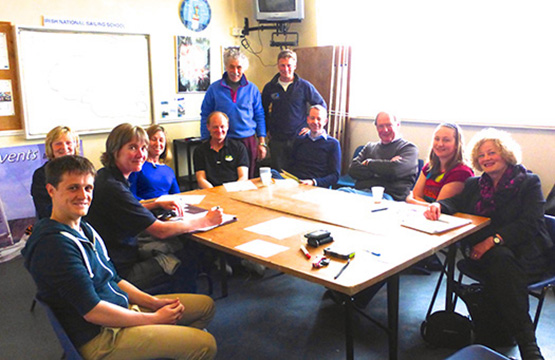 First committee meeting of the Irish National Sailing Club on Monday May 10th 2015. The committee and school management of the newly-formed Club are (left to right) Glyn Williams (foreground), Muriel Rumball, Joan Sheffield, Caroline Herron, Robin Jones, Alistair Rumball, Kenneth Rumball, Garrett O'Malley, Dermot Igoe, Heather Blay and Mary Beck. Photo: W M Nixon
First committee meeting of the Irish National Sailing Club on Monday May 10th 2015. The committee and school management of the newly-formed Club are (left to right) Glyn Williams (foreground), Muriel Rumball, Joan Sheffield, Caroline Herron, Robin Jones, Alistair Rumball, Kenneth Rumball, Garrett O'Malley, Dermot Igoe, Heather Blay and Mary Beck. Photo: W M Nixon
Such is the stature of the Irish National Sailing School that it has been selected as the venue for one of the key assemblies in the up-coming series of Irish Sailing Association Regional Cluster Development Meetings, which seek to improve inter-club relationships and facilitate regional co-operation for the mutual benefit of the many and varied club memberships in specific areas.
The ISA East and Southeast Regional Development Officer Sarah-Louise Rossiter will be holding the meeting for sailing and yacht clubs in the Dublin South Cluster in the Irish National Sailing School from 7.0pm to 9.0pm on Wednesday October 7th.
We can only hope that some of the stardust now exuding from the INSS will waft on to those from other clubs. Alistair Rumball, founder of the INSS way back in 1974, helpfully explains how it’s done: “There’s nothing special to it. You just have to have everyone prepared to work 15 hours a day seven days a week, and be mad keen about teaching and sailing. That’s all it is. Simple as that really”.
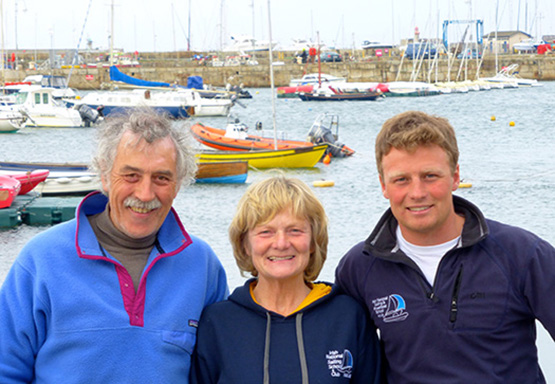
The National Sailing School’s Alistair and Muriel Rumball and their son Kenneth. “You just have to have everyone prepared to work 15 hours a day seven days a week, and be mad keen about teaching and sailing. That’s all it is. Simple as that really”.
Cruiseship Sets a Course for Visit of German Corvette to Dun Laoghaire
#GermanCorvette - Following German cruiseship caller Mein Schiff 4 offshore of Dun Laoghaire Harbour yesterday, the port this month is to welcome a corvette also from the same country, writes Jehan Ashmore.
The 90m long 1,850 tonne German Navy vessel ‘Ludwigshafen am Rhein’ (F264), is the final of five ‘Braunschweig’ class corvettes that was commissioned into service in 2013.
She is to pay a four-day visit to the harbour from the 25th-28th September. During next weekend the corvette will be open to the public at the Carlisle Pier on Saturday 26th (13:00 – 17:00) and on Sunday 27th (14:00 – 16:00).
It should also be noted that another German naval visitor, Gorch Fock, a sail trainee ship is currently nearing the end of visit to Dublin Port that began more than a fortnight ago. Also berthed at Sir John Rogersons Quay is an expedition luxury motoryacht, M.Y Turmoil built in 2006 that arrived from Cork today.
She is a stark contrast to the 1958 built tallship which as previously reported on Afloat is to have a second ‘Open Ship’ for the public held tomorrow, Sunday (20th September).
Tours of the three-masted sail barque are between 14:00-17:00, and where her crew will welcome you on board.
So why not make a visit (free of charge and no registration) to the vessel that has made an impressive 168 cruises.
Gorch Foch is to depart next week, on the Monday when she sets sails to Funchal, Portugal. A further call on the Iberian Peninsula is to take her to Cadiz in neighbouring Spain.
The final leg of this cruise is to involve a return crossing of the Bay of Biscay in November with the final leg from Dartmouth to Wilhelmshaven back in Germany.
Cathy MacAleavey & Con Murphy Win Water Wags Race
The arrangements for the Water Wags Walpole Prizes were modified to ensure that the results could contribute to the overall championship. The terms of presentation asked for two races, one race for those who had competed in more than six races without a race win, and one race for the rest of the Water Wags.
The race was programmed to start at 18.30, but at 18.00 the Irish Light’s vessel Granuaile motored into the harbour, did not drop anchor, put somebody ashore, and half an hour later somebody returned to the ship and she motored out of the harbour mouth. Meanwhile there was absolutely no wind in the harbour. By the time she left there was about 3knots of wind from the north. A course was laid, and immediately the wind shifted to the north west.
Thus, the race had to be reduced to two laps of the harbour. It appears unlikely, but there was absolutely no evidence of tidal flow within the harbour.
At the first windward mark Mollie led from Pansy and Swift. These three were able to hold their places for the duration of the race.
After two laps the race was shortened at the leeward mark due to failing light. The results were:
1st. ‘Mollie’ Cathy & Con Murphy.
2nd. ‘Pansy’ Vincent Delany & Noelle Breeen. Winner Walpole Prize div 1A.
3rd. ‘Swift’ Guy & Jackie Kilroy.
4th. ‘ Ethna’, Bill Nolan & Niamh Hooper.
5th. Skee, Jonathan & Carol O’Rourke. Winner Walpole Prize div 1B.
6th. ‘Tortoise’, William & Linda Prentice.
7th. Alfa, Michael & Jenny Donohoe.
8th. ‘Scallywag’ Dan O’Connor & David Williams.
9th. Freddie, David Corcoran & Philip Mayne.
10th. Marcia, Ben & Maureen McCormack. Winner Walpole Prize div 2.
11th. ‘Moosmie’, David & Sally MacFarlane.
12th. ‘Polly’ Henry Rooke & Richard Mossop.
13th. ‘Marie Louise’, John & William Magner.
14th. ‘Sara’, Paul & Ann Smith.
15th. Good Hope, Hal Sisk & Sue Westrup.
16th. ‘Penelope’, Fergus Cullen and Alice Walshe
17th. Mademoiselle, Adam Winkleman & Goug Smith
18th. ‘Coquette’, Seymour Cresswell & Mary.
19th. Sprite, Adrian Masterson & Jeff Davys.
20th ‘Eva’, Ian McGowan
21st. Eros, Gail Varian & Gavan Johnson.
22nd. Nandor, Brian McBride and Stuart McBean.
23rd. ‘Little Tern’, Marcus Pearson & friend.
Christy Moore Supports Eco Plan Redevelopment of Dun Laoghaire Harbour
#SOSharbour - A campaign by the Save Our Seafront has vowed to ramp-up its efforts to prevent a jumbo cruise berth being developed in Dun Laoghaire harbour.
The Herald reports that an eight-year planning application for the cruise berth is being considered by An Bord Pleanala.
At a recent public meeting, campaigners decided their next course of action, after making submissions on the planning application.
"We hope that the planning route will be enough for us to stop this," People Before Profit TD, Richard Boyd Barrett said.
"But in the meantime we are encouraging people to write to Transport Minister Paschal Donohoe about the upcoming harbours bill," he added.
Legislation that is being processed at the moment could see the Dun Laoghaire Harbour Company (DLHC) disbanded and the harbour brought under council control.
Mr Boyd Barret said that he will be seeking an amendment that would ensure that the harbour would be under the control of elected representatives.
Musician Christy Moore , who lives in Monkstown, has backed the campaign.
For more about the Appeal and the restoration of a ferry service to Holyhead in 2016, click here.
New Cruiseship 'Mein Schiff 4' to Make Irish Debut off Dun Laoghaire
#NewCruiseShip – A new cruiseship, Mein Schiff 4 with a capacity for 2,506 passengers and more than 1,000 crew is to make her Irish maiden cruise with a debut call offshore of Dun Laoghaire Harbour next week, writes Jehan Ashmore.
Operating the Finnish built 99,500 tonnes vessel launched in late 2014 for TUI Cruises, the Mein Schiff 4 (My Ship 4) is to call to Dun Laoghaire. She will make the inaugural Irish port of call for the German based joint venture tourist group.
Mein Schiff features a 25m swimming pool, basketball court, sauna with sea view and where her guests can expect to pay €5,495 for a suite on the 10-day cruise.
The visit of TUI Cruises has been welcomed by Dun Laoghaire Harbour as German tourists are to celebrate in the searching of a slice of their ‘Irishness’ and where traditional music session will greet the visitors ashore.
Also taking place this month is the annual Oktoberfest held in Dublin, where currently the German Navy tallship Gorch Fock is berthed as previously reported. Tours of the vessel are this Saturday, for further details visit the story.
Secondly, a corvette also from the German Navy is to call later this month to Dun Laoghaire. Afloat will have more on this in a separate report covered on our Naval Visitors page.
Returning to the cruise sector, unlike the previous giant white-hulled cruiseships, Mein Schiff 4 sports a deep blue hull with the company’s distinctive livery. This is conveyed through hand-written like script with words spread across her amidships.
She is the second of almost four identical sisters based on an order from Finnish yard, Meyer Turku.
The next pair, Mein Schiff 5 is due for delivery in 2016 and final sister, Mein Schiff 6 will follow in 2017. The yard was taken over by the German shipbuilder earlier this year, resulting in the end of the Finnish Government stake-holding.
The call of Mein Schiff 4 on 18 September, will represent the end of the 2015 season to Dun Laoghaire.
Earlier this year it had been expected the season would be record-breaking with 22 cruise calls, however the scheduled figure have been considerably reduced by around a half.
The reason for this spate of cancellations throughout the summer by the largest cruiseships, notably the majority from Princess Cruises 3,600 passenger Royal Princess which instead went to Dublin Port to avoid the issue of anchoring off Dun Laoghaire.
Such a process is time-consuming for operators in having to transfer passengers ashore to the south Dublin Bay harbour.
The Royal Princess had only made a once off call off Dun Laoghaire that launched the season in May. All of the subsequent 8 calls were cancelled and transferred to Dublin Port which was given the ‘green’ light to proceed with a €30m double cruise-berth terminal.
While, DLHC await planning permission for a €18m single cruise-berth facility, all was not lost as the harbour welcomed the return for the second time in recent years of the prestigious Cunard 148,500 tonne cruise-liner, Queen Mary 2 which called also in May.
Another positive for DLHC was the repeat calls this season by Windstar Cruises sail-assisted five-masted Wind Surf that docked inside the harbour.
Also making calls within the harbour arms at the Carlisle Pier was Windstar Cruises newly acquired Star Legend. She previously made an appearance last year when under the ownership of Seabourn Cruises.
Guinness Six-Pack As Brewing Tanks Unloaded in Dun Laoghaire Harbour
#GuinnessTanks – The first anniversary of the closure of the Stena HSS Dun Laoghaire-Holyhead route is tomorrow, however, the harbour witnessed a cargoship dock in recent days to unload brewing fermentation tanks for Guinness, writes Jehan Ashmore.
Asides the occasional cruiseship caller this season that docked inside the harbour, the call of a cargoship is rare, given the last shipment of brewing tanks was more than a year ago as previously reported on Afloat.ie. That batch of fermentation tanks was carried on board the cargoship Wilson Goole, operated by Norwegian owners Wilson Ship Management of Bergen.
On this occasion a fleetmate, Wilson Blyth (1995/3,713dwt) docked in Dun Laoghaire over the weekend rather than Dublin Port. This was due again to bridge-height restrictions in transporting brewing vessels by trucks along the city quays to St. James Gate Brewery.
On board Wilson Blyth there were six stainless-steel brewing vessel tanks manufactured by Dutch firm, Holvrieka that were loaded at Rotterdam from where the cargsoship arrived to Dun Laoghaire on Sunday.
Each of the 4.24 khL brewing vessels weigh 27.5m tonnes and has space to store 750,000 pints of beer. They will provide Diageo with extra fermentation and maturation capacity.
Colin O’Brien, Operations Director for Diageo’s supply business in Ireland, said: “These vessels, representing an investment by Diageo of nearly €10m, will enable us to meet the growing demand for our beers and to bring new products into the market. The investment underscores our continued investment in brewing in Ireland and the role that Diageo is proud to play in the Irish economy, supporting employment, exports, agriculture and tourism.”
The new brewing vessels measure 6m in diameter and 26m will be able to ferment or store up to 424,000 litres of beer and provide an extra 300,000 hectolitres of extra fermentation capacity annually.
Currently, the gleaming brewing tanks remain on the Carlisle Pier having been unloaded yesterday by a mobile mounted road-crane. This involved hoisting four of the brewing vessels from the hatch cover while the remaining pair where removed from the hold. Having discharged her cargo, Wilson Blyth took a pilot from the Dublin Port cutter Camac and set sail last evening.
The brewing vessels are to be transported in convoy to St. James’s Gate in the early hours of tonight (Wednesday morning, 9 September), when traffic is at its lightest.
Diageo are working with Dublin City Council, Dún Laoghaire-Rathdown County Council and An Garda Síochána to minimise disruption to traffic and to residents living along the route.
Save Dun Laoghaire Harbour Campaign Is A Fight Against The Clock
A well-attended and widely-representative Public Meeting in the Kingston Hotel in Dun Laoghaire last night heard that those who wished to save Dun Laoghaire Harbour from a disproportionately large new Cruise Liner Berth – and a hidden agenda of excessive waterfront apartment and commercial development – would have to make their case within a very tight timeline of proposed legislation at both government and local authority levels within the next few days and weeks writes W M Nixon.
Local TD Richard Boyd Barrett made the point that the preparatory proposed legislation for a bill to transfer control of the Harbour Company to Dun Laoghaire/Rathdown County Council was introduced on the very last day of the Dail term before the 2015 Summer Recess. This means that as soon as the Dail resumes sittings in the near future, if the Government is determined to push the legislation through in its present unacceptable form, it will require diligent attention and determined opposition by concerned TDs to introduce the essential amendments which will meet the hopes of those who wish to preserve Dun Laoghaire Harbour largely as it is.
Thus it is essential that all local TDs and a majority of Councillors become persuaded of the need to maintain Dun Laoghaire Harbour as intact as possible, both as a priceless part of our national heritage, as a major asset for maritime sport and recreation, and as a port of call for smaller specialist cruise vessels.
The meeting was chaired by Cllr Melissa Halpin of Dun Laogaire/Rathdown CC, who emphasized the need to determinedly lobby all local representatives, a viewpoint which was enthusiastically reflected from the floor when the meeting was thrown open for public discussion, as was the need for increased use of social media in support of the campaign.
Before that, an informed panel of speakers set out the scenario whereby a unique Victorian harbour on an unrivalled scale could be changed out of all recognition for the worse by imbalanced development aimed mainly at short-term commercial gain, but in the long term resulting in the very destruction of those features of the harbour which currently make it such an attractive target for developers of all kinds, whether in property or liner berthing.

Cllr Melissa Halpin was Chair of a crowded public meeting on Dun Laoghaire harbour in the Kingston Hotel last night.
Dun Laoghaire resident author and curator Alison Hackett provided an overall vision of the harbour as an essential and unique space which has become central to the very special attractions of Dublin Bay. Then Fergal McLoughlin of An Taisce outlined the harbour’s exceptional position, both as a local and national recreational asset, as a facility which can continue as a working harbour provided that the ships using it are kept within proportion and respect its overall size, and as a very important and unusual part of our built heritage.
 Alison Hackett
Alison Hackett
 Fergal McLoughlin of An Taisce
Fergal McLoughlin of An Taisce
Renowned sailing enthusiast Liam Shanahan Senr of the National Yacht Club followed, outlining his own ideas of how best the harbour’s future might be shaped, based on the notion that it should be given its own special Public Park status. He strongly made the point that those who wish to preserve the best features of the overall harbour would have to bring a businesslike approach to their proposals, and that the people of Ireland would have to see a clear national benefit if Dun Laoghaire was to become the focus of a resurgent maritime recreational growth.
He proposed that a public Sailing School be established, not in opposition to established sailing schools already operating in Dun Laoghaire, but drawing on their experience to encourage an even wider sector of the public to give sailing and boating in all its form a completely free first try. He concluded, however, by emphasizing again the need for a businesslike approach, making the point that they cannot expect the public funds to become available unless the required figures are outlined in a clear and positive terms, and that it is made clear why sport, recreational and cultural activity are the best use of this special national asset.
Richard Boyd Barrett then concluded the formal side of the meeting by emphasizing again the urgent need for rapid political action. His great concern was that though the control of the Harbour Company might in effect be transferred to the County Council, the CEO of the Council could end up making commercial decisions about the future of the harbour with being restrained by any final democratic control from the council.
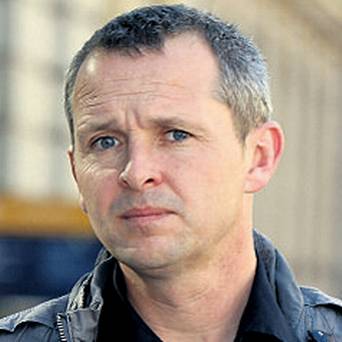
Richard Boyd Barrett TD
This is a worry which was later reflected from the floor, when several speakers voiced the concern that, as the County Council had somehow permitted the building of the controversial Dun Laoghaire Lexicon library building when in theory they should have been in control, equally the major decisions regarding the Harbour Company’s future might be made regardless of the real wishes of the Council.
Richard Boyd Barrett has a clear policy on this, as he wishes to see the formal establishment of a statutory Harbour Users Forum whose members would be made up of stakeholders in every aspect of the harbour’s use, and whose decision would carry real rather than merely advisory power. He was particularly clear in his wish to have such a body established, but was in no doubt about the political challenge involved in setting it up and giving it real teeth.
The discussion from the floor indicated the huge range of interests and concerns which the various harbour proposals have aroused. The Harbour Company’s Cruise Liner Berth Plan is now before An Bord Pleanala, and despite a short time scale, 180 written submissions were received, making an Oral Hearing more likely.
On the sailing side, the four Dun Laoghaire Combined Clubs have come together with commendable speed to produce a very detailed set of written proposals which has the full support of the Irish Sailing Association, while additional ideas have come from other reacreational harbour users such as the venerable Water Wag Class which date from 1886.
As well, speakers from the floor referred to a wide range of possibilities, notably the use of smaller cruise liners with not more than a thousand passengers. These would be ships which could use the existing shoreside facilities, yet would also be more likely to bring the kind of discerning passenger who would better appreciate Dun Laoghaire’s special features, and be more likely to spend in the town’s struggling retail sector if it in turn could be better geared to meet their needs.
The next few days, weeks and months will see far-reaching decisions on Dun Laoghaire Harbour’s future. It is Ireland’s largest recreational boating centre. Thus the outcome of these intense debates, public forums, and decisions by statutory and governmental bodies will affect everyone who is interested in the maritime world at whatever level, as well as the many thousands of people who have a special interest in Dun Laoghaire simply because it is at present a charming place to be beside the sea.
Those who first proposed the building of this monumental structure more than two hundred years ago as a “Harbour of Refuge” for sailing ships transitting Dublin Bay can scarcely have imagined that almost exactly two centuries later, the future of this harbour is a subject of even more intense debate and passionate feeling. The fact that it is will in turn become part of its heritage.
#CancelledCruiseCall -The biggest ever cruiseship built exclusively for the UK market is no longer listed as scheduled to visit Dun Laoghaire Harbour according to the port company website, writes Jehan Ashmore.
Once again another massive cruiseship is not calling offshore of Dun Laoghaire Harbour. As previously reported on Afloat.ie the 147,000 tonnes P&O Cruises 2015 built Britannia was due to call next Tuesday on her maiden call to Dun Laoghaire Harbour. Instead of anchoring she is to favour docking in Dublin Port that same day according to the port's vessel arrival list.
As also reported, Britannia is as scheduled to make a first call to Cobh next week on the following Wednesday.
Afloat await a response from DLHC to make a comment on the cancellation by the prestigious cruise operator. The port company today launched online all documents of the planning application lodged to An Bord Planeala and where a public consultation period over a seven-weeks began today for submissions /observations on the proposed €18m cruise-berth.
When the 3,600 passenger capacity Britannia is due to call to Dublin Port she will arrive to berth 33 within Alexandra Basin.
It is at this same berth is where a near-sister of Britannia, the Princess Cruises operated Royal Princess also favoured the capital instead of calling offshore of Dun Laoghaire on 28 June. This was the third successive cancellation by the 2013 built Italian cruiseship and this has reduced a record-breaking season that was expected to total 23 cruise calls.
On the same day the Royal Princess called to Dublin Port on 28 June, Afloat reported the sail-assisted five mast cruiseship Wind Surf that made an earlier than scheduled arrival to Dun Laoghaire. She was due the next day. The reason for the early diversion were high-winds that prevented the Windstar Cruises flagship from launching tenders to bring guests ashore to Dunmore East.
It is for similar and operational reasons that massive cruiseships do not make anchorage calls. On the occasion of the inaugural cruise call for the DLHC cruise season on 11 May, MSC Cruises decided to swap the port of call to Dublin Port with the 137,000 tonnes MSC Splendida visiting on the same day to the capital. For a report of her second call to the port click here.
The cruise operator citing that passengers had the convenience of proximity to the capital with more time spent rather than having to be tendered ashore via Dun Laoghaire Harbour.
A further three cruise calls by separate ships are due to Dun Laoghaire this season.
The MSC Splendida, as previously reported on Afloat was confirmed by DLHC to make her long awaited first visit with a call offshore next month.


























